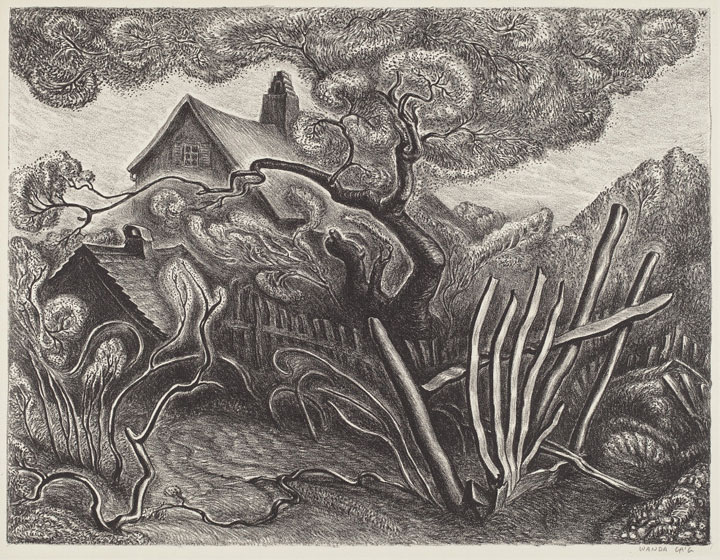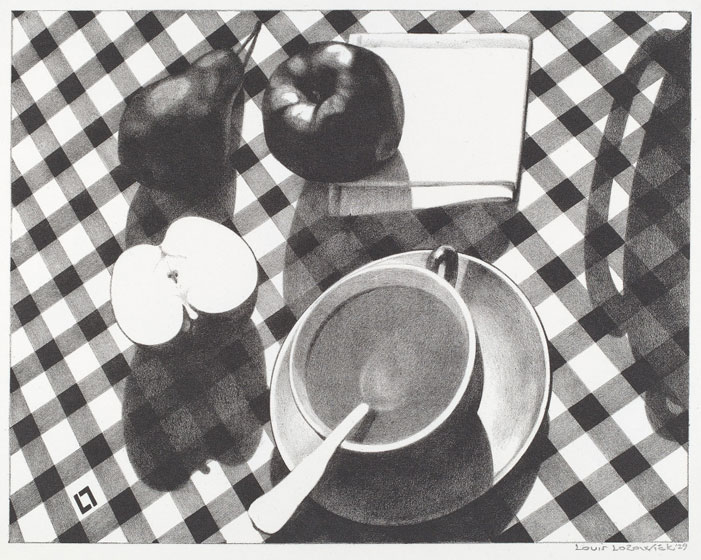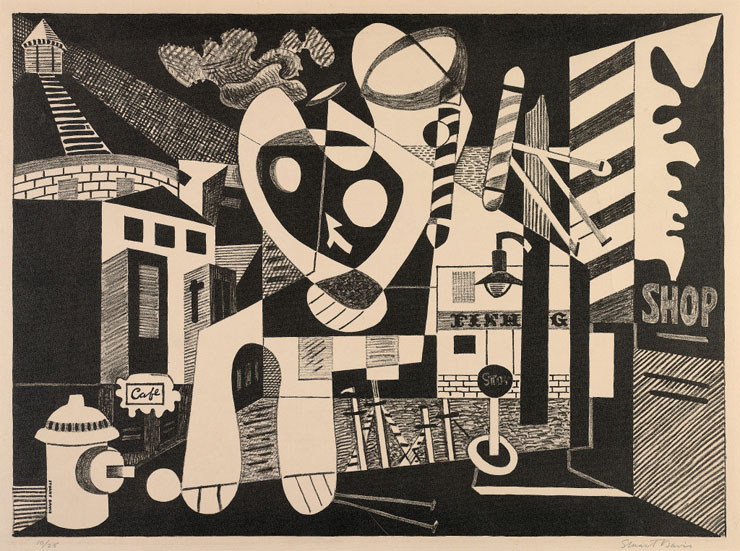Modern American Prints and Drawings from the Kainen Collection

Zorach is perhaps best known as a sculptor, but throughout his career he countered the arduous demands of carving and modeling by painting free-flowing watercolors. Working on wet paper so that his colors bled, Zorach traded tight control for improvised form and brilliant color and luminosity, interested, as he stated, “in interpretations rather than naturalism.”
William Zorach, American, born Lithuania, 1887 – 1966, View of Distant Hills, 1915, watercolor on Japanese paper, Gift of Ruth Cole Kainen, 2005

The historic Long Island town of East Hampton, New York, became Hassam’s home in 1919 and featured prominently in many of his works thereafter. This etching depicts the entryway to the 1715 Nathaniel Dominy house, where several generations of cabinetmakers and clockmakers had resided. By Hassam’s time, the structure had fallen into disrepair, wisteria nearly overtaking its door (the house was demolished in 1946). Hassam melded the doorway, vines, clapboard, and windows in shimmering, broken luminosity.
Childe Hassam, American, 1859 – 1935, Old Doorway, East Hampton, 1920, etching, Gift of Ruth Cole Kainen, 2005

Monotype is a process in which the artist paints directly on a smooth, blank printing plate, then immediately places a sheet of paper on top of the plate and runs it through a press. Most of the ink transfers from the plate to the paper, creating an image that is usually printed only once, and is thus unique.
Gifford Beal, American, 1879 – 1956, Sailboat and Sunset, c. 1920, monotype, Gift of Ruth Cole Kainen, 2005

Gág, a Minnesota-born artist, was also a writer and illustrator of children’s books. She received many prestigious awards, including both Newbery and Caldecott honors. This print is reminiscent of the style of her illustrations in Millions of Cats—a publication that has been issued in new editions continuously since 1928.
Wanda Gág, American, 1893 – 1946, Spring in the Garden (Spring II), 1927, lithograph, Gift of Ruth Cole Kainen, 2005

While studying in New York City at the National Academy of Design and at Columbia University Teachers College, Wells discovered his affinity for printmaking. He was especially drawn to woodcut and linocut—relief printing processes in which the image is cut into wood or linoleum. Editors commissioned prints from him to illustrate key sociopolitical publications such as The Crisis, Opportunity, The Dial, and The Golden Book. In 1929, a year after making Looking Upward, Wells moved to Washington, DC, where he joined the faculty of Howard University.
James Lesesne Wells, American, 1902 – 1993, Looking Upward, 1928, linocut, Gift of Ruth Cole Kainen, 2005

Louis Lozowick, American, 1892 – 1973, Still Life #2, 1929, lithograph, Ruth and Jacob Kainen Collection, 1989

Davis often blended abstract forms with recognizable motifs. Barber Shop Chord merges sites in Gloucester, Massachusetts, where Davis summered, and Place Pasdeloup, a neighborhood he knew from an earlier stay in Paris. His innovative integration of contemporary subject matter, such as commercial and street signs, prefigured the development of pop art in the 1960s. Davis and Jacob Kainen were friends, and both were employed by the Works Progress Administration’s Federal Arts Project during the Depression. Davis encouraged Kainen to join the Graphic Arts Division of the project—an important step in Kainen’s development as a printmaker and print expert.
Stuart Davis, American, 1892 – 1964, Barber Shop Chord, 1931, lithograph, Gift of Ruth Cole Kainen, 2005

In 1934 the studios of Gorky and Jacob Kainen were in close proximity, and the two artists became friends. Gorky gave this drawing to Jacob as a thank you for sitting for an oil portrait. Years later, Jacob sold it, an act he always regretted. Ruth Kainen tracked the drawing down and purchased it for Jacob in 1998, allowing him to enjoy it in his final years.
Arshile Gorky, American, born Armenia, 1904 – 1948, Study for Nighttime, Enigma and Nostalgia, 1934, pen and ink, Gift of Ruth Cole Kainen, 2012

Among Gottlieb’s most important works are those he called “Pictographs,” spanning most of the 1940s and into the 1950s. These feature open-ended symbols loosely arranged in a grid with no clear hierarchy or narrative. Gottlieb encouraged viewers to free-associate as a way of releasing their imaginations and accessing their subconscious selves.
Adolph Gottlieb, American, 1903 – 1974, Pictograph, 1946/1947, watercolor heightened with white and gold, Gift of Ruth Cole Kainen, 2006

Milton Avery, American, 1885 – 1965, Sea and Rocky Shore, 1948, watercolor over graphite, Gift of Ruth Cole Kainen, 2005

Karl Schrag, American, 1912 – 1996, The Influence of the Moon, 1950, etching, aquatint, and softground etching, Gift of Ruth Cole Kainen, 2005

While Kainen started out as a social realist depicting the plight of the common man during the harsh times of the Depression, he later shifted toward abstraction. Even as the title and visual components of Sun in the Hills suggest topography, the forms invite appreciation for their own abstract qualities.
Jacob Kainen, American, 1909 – 2001, Sun in the Hills, 1951, woodcut and stencil, Gift of Ruth Cole Kainen in honor of the artist's 90th birthday, 1999

This work belongs to a series in which Pollock dripped black ink onto the top sheet of a stack of thin Japanese papers, allowing the ink to seep through to underlying sheets. In this instance, he turned one of the sheets over and added black and sepia ink to the back. The drawing was purchased by Ruth Kainen in 1969, the year she and Jacob wed. Even after their marriage the couple continued to develop their collections independently.
Jackson Pollock, American, 1912 – 1956, Untitled, 1951, ink on Japanese paper, Gift of Ruth Cole Kainen, 2012

Smith mixed egg yolk into black ink to make a medium that was more viscous and translucent. By working on paper large enough to accommodate his expansive brushstrokes he immersed himself in the act of drawing with the same physicality he used to make sculpture. Smith wanted drawing to be second nature, stating that he sought to employ gestures as natural as those used to dress or to eat.
David Smith, American, 1906 – 1965, Untitled, 1957, brush and ink mixed with egg, Gift of Ruth Cole Kainen, 2012

Dorothea Tanning, American, 1910 – 2012, At These Rites, 1973, aquatint and sugar-lift aquatint, Gift of Ruth Cole Kainen, 2005

Between working sessions, de Kooning would keep the oil paint on his canvases from drying by covering it with newspaper. By the 1960s, he began incorporating these pieces of oil-saturated newsprint into his images. He pulled this two-page newspaper spread away from the wet canvas and mounted it to another support in order to manipulate the image further.
Willem de Kooning, American, born The Netherlands, 1904 – 1997, Untitled, 1976, oil on newspaper mounted to canvas, Gift of Ruth Cole Kainen, 2012

Although best known for her sculpture, Nevelson also created extraordinary prints. In the Magic Garden is among the first she made, having executed the plate at Atelier 17, the influential workshop of Stanley William Hayter. When Nevelson traveled to Mexico in 1950, she became inspired by pre-Columbian art, especially Mayan figurative sculpture and ruins. Upon her return, she improvised on their blocky, mysterious forms in her etchings.
Louise Nevelson, American, 1900 – 1988, In the Magic Garden, 1953 – 1955, softground etching, etching, engraving, and aquatint, Gift of Ruth Cole Kainen, 2012